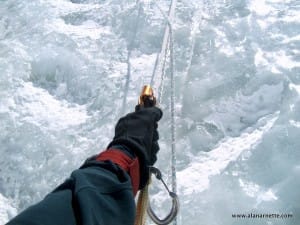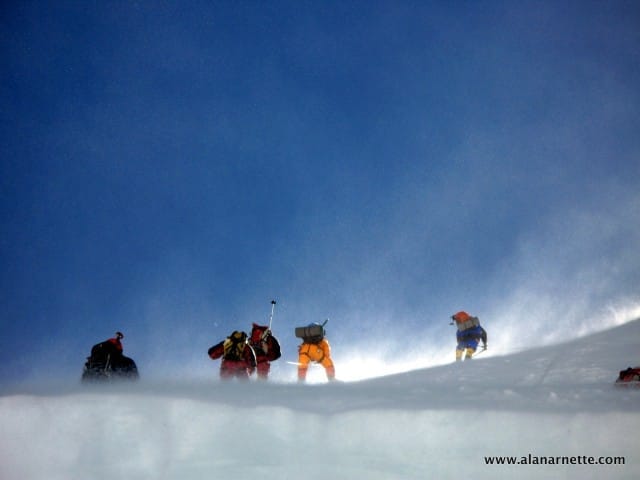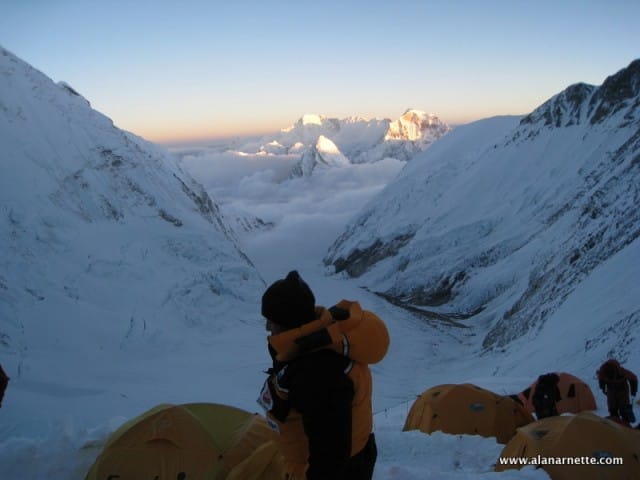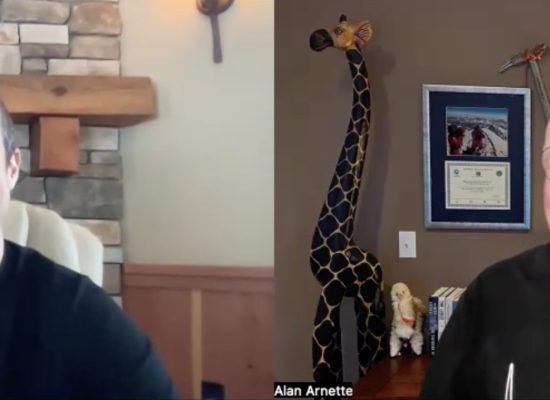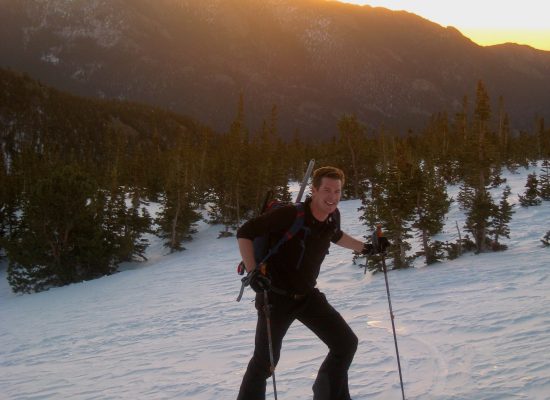Poor weather is delaying getting the fixed ropes to Everest’s summit on both sides but is looking better. The Nepal side Everest permits have reached 444, with more permits issued each day. EverestER has seen over 400 patients thus far. Some teams have completed their acclimatization protocols while others haven’t started. An interesting season to be sure! Also a narrative on climbing From Camp 1 in the Western Cwm to Camp 3 on the Lhotse Face.
Each weekend during the season, I’ll post a “Weekend Update” summarizing the main stories from the past week what to expect next, and more posts whenever there is meaningful news.
Big Picture
High winds have slowed progression on both sides of Everest, but it looks like they are calming so we can expect a lot of movement this next week. Meteorologist, Chris Tomer who has multiple clients on both sides told me:
The jet stream (superhighway of wind at 30,000ft) dictates weather on Everest. We’re seeing fragments of the jet brush the summit (40-80mph summit gusts predominantly from the West-Southwest), and I expect that to continue through early 5/9 then we’ll enter a period of lighter wind with less jet influence. The pattern also looks relatively dry for the next week. These factors should allow rope teams to make progress after early 5/9. Looking at the Bay of Bengal, right now I don’t see any signs of tropical development.
Nepal’s Everest permits have slowed down after a fast start and will probably not reach the predicted 500 level, while on the Tibet side when you count all types of climbers, foreigners, Chinese, Tibetans, and Sherpas, there will be close to the 300-person limit.
Last year, 2024, the Tibetan rope fixing team summited on May 7, opening the route to all climbers, but it will be later this year due to poor weather. The fixed line is only to the Yellow Band on the Nepal side and 7900 meters, between Camps 2 and 3 on the Tibet side.
Last Week
Many of the Nepali-guided teams completed their acclimatization rotations to Camp 2, with some tagging 7000 meters on the Lhotse Face. Only a few Western teams did the same, so we have a mixed bag in terms of climbers ready to summit, but that’s a moot point given the fixed line is only to 24,500 ‘/ 7467m. There’s a long way to go to reach the summit at 29,031 feet or 8848 meters. The 8K Expeditions Sherpas are doing the best it can, but with high winds, it is too dangerous to be high on the mountain.
Kevin Sanchez climbing with Climbing the Seven Summits messaged me from Camp 2 saying the “Western Cwm felt like Phoneix in July,” now that’s hot!
Lhapka Sherpa with 8K Expeditions provided a good update on Friday with a nice video of climbers in the Icefall. “Most of our team members have completed climbing rotations, while a few are still making their way up. Currently, weather conditions above the high camps remain unstable. Despite the challenge, our rope fixing team has successfully secured the line up to the Yellow Band and is now resting at Base Camp. Once the weather clears, we aim to push for Camp 4 without delay.”
Seven Summits Treks reported a record number of clients this year: “Spring 2025 is undoubtedly one of the biggest seasons that we’ve managed so far. Regions like Everest, with over 100 climbers, and Annapurna saw a good many aspiring climbers, and it is our responsibility to meet each climber’s individual needs. This is a record-breaking year for SST.”
Everest ER, the all-volunteer medical clinic at EBC-Nepal, gave an update on their busy season:
The incredible dedication of our volunteer physicians at EverestER shines brightly this April! They’ve already touched the lives of over 400 patients, facing the formidable challenges of high-altitude medicine head-on. Among these courageous individuals were nine cases of High Altitude Pulmonary Edema (HAPE), a stark reminder of the environment’s harsh realities. Right now, our team is providing critical care in the clinic tent for one HAPE patient, a testament to their unwavering commitment as they await a potentially life-saving evacuation in the morning. While the mountain brings its unique dangers, the most frequent visitors to our clinic have been those battling upper respiratory tract infections and persistent coughs – a common thread in this breathtaking yet demanding landscape.
There was an under-reported rescue in the Icefall last week, now made visible by “The Everest News:
In a heroic act of bravery and swift action, three Sherpa guides successfully rescued 70-year-old Russian climber Iurii Sukhanov, who had fallen into a crevasse below camp-1 while on an expedition to Mount Everest. The incident occurred on April 26 at an altitude of approximately 5,600 meters, just below Camp-1 of Everest. Sukhanov fell nearly 15 meters deep into a crevasse when the ice suddenly broke. The rescue was carried out by Fortenbach Adventure’s experienced Sherpa team consisting of Lakpa Tenzing Sherpa, Pemba Gelu Sherpa, and Ram Magar.
On the Tibet side, the ropes are to 7900 meters between C2 and 3. Base Camp is well established for all the teams there: Alpenglow, a Chinese team, Climbalaya Treks & Expeditions, Furtenbach Adventures, Himalaya Expeditions, Kobler & Partner, and Imagine Nepal. Sherpas from all teams have or are in the process of establishing Intermediate and Advanced Base Camp. The Chinese team may have already slept at the North Col, so could be the first to summit this season. It’s been unusually snowy on the Tibet side per Jason Weiss with Climbalaya who sent me this image:

Next Week
We will see Base Camp fill up and more teams begin their acclimatization rotations to Camp 1 and 2, some tagging 7000 meters before returning to Base Camp. I expect to see 8K get the fixed line to the South Col, perhaps higher to the Balcony.
On the Tibetan side, the Tibetan rope team will make good progress, often they summit before the Nepal side, so we will see.
Other 8000ers
Annapurna–Over
The Anna season ends with close to forty summits and two tragic Sherpa deaths. Anna had six teams with sixty-six clients.
Dhaulagiri–Climbing
Pakistani sensation Sajid Ali Sadpara is ready, “Rotation completed on Dhaulagiri world’s 7th highest mountain. remember in prayers next push is summit push inshallah.” Adrian Hayes told me a few days ago, “Bc 10 days ago, first rotation to C1 for most last week, very heavy snow since, good weather now, and rotation #2 to C 2 and 3 likely tomorrow or Friday for all.” This season, fifteen foreigners have permits for Dhaulagiri across two teams.
Kangchenjunga–Climbing
Seven Summits Treks and Altitude Junkies are two of the four teams there. With a weather window emerging, look for summits around May 6th. Forty-one people have climbing permits.
Makalu–Climbing
With the fixed rope to the summit, we can anticipate the commercial climbers beginning their rotations and summit pushes soon. Madison Mountaineering is headed there this weekend. This season, 66 foreigners have permits for Makalu across six teams.
Update on the Everest Rule PROPOSAL from Nepal
As I reported last week, the Kathmandu Post reported, “According to the Integrated Tourism Bill registered in Nepal’s upper house of Parliament on April 18, any climber wishing to set foot on Everest must first have conquered a mountain over 7,000 meters.”
One question I had was if the 7000-meter requirement was only for Nepalese 7000ers., it does, thus, a huge problem will definitely reduce the number of foreigners coming to Nepal for Everest. The second requirement made it mandatory for the sirdar (head Sherpa), high-altitude guides, and helpers on every expedition to be all Nepali citizens. It does, so again if foreign guides are not allowed to run their own expeditions, look for a massive reduction in foreign climbs. I suspect both of these clauses will be changed IF the bill passes at all, which is doubtful.
Ticket to the Top
This week’s narrative takes us from Camp 1 through the Westen Cwm and then up the Lhoste Face for our acclimatization rotation.

The last rotation is, in many ways, your last chance. If you don’t accomplish the objective of reaching at least Camp 3 on the Lhotse Face or to the North Col, your chances of making the summit are reduced. As I was told one year, “This is your ticket to the top.”
In some ways, it should be the easiest because you are not going for the summit, thus reducing pressure, but you are marking your high point. If you have never climbed an 8000-meter peak, this is all new ground, which is why I always suggest climbing Cho Oyu, Manaslu, or Gasherbrum II before Everest – at this point, those who have not don’t know what they don’t know.
In the old days, circa 2011 :-), the usual schedule had climbers spend a difficult night at Camp 3 or the North Col without oxygen. Around 23,500/7100m, this is extreme altitude, and you will soon know if your body has any chance of surviving higher, even with supplemental oxygen. If you struggled to get to this level, your chances of summiting were low. This is a hard, cruel fact that guides are often delivered in hard, cruel ways—for your protection.
Today, 2025, almost no team spends a night at Camp 3 as they begin using supplemental oxygen from Camp 2, and most guides feel the strain on their clients is too much when they overnighted at 3.
Let’s go inside a climber’s head about this week’s activities.
The Western Cwm on the South
The trek between Camp 1 and Camp 2 in the Western Cwm is part of the route that cannot be avoided, but about halfway through, you begin dreaming of helicopters.
A Long Night at Camp 1
Morning came none too early. This was your first night at this altitude and you did the crocodile roll all night long. You went through your entire Spotify download collection, including the ones a few friends added as a joke. Not funny at 4:00 am in pitch black, watching your breath create a monsoon layer of rain forest moisture on the tent roof. It was not a fun night … and you have many more of these as each time at a new altitude, you have to pay the price.

The plan is to get up early before the Cwm heats up, dress, drink coffee or tea (with sugar sugar sugar), maybe some porridge, gear up, and then off to Camp 2. How bad can this be? The morning is perfectly clear, no wind. The weather forecast calls for the same all day. You have an energy in your step that feels good. You are eager to get to Camp 2 at the base of the Lhotse Face. It’s only 500 meters/1,500 feet higher, and you were told about 3 km or 1.75 miles. How bad could this be?
March
“OK, listen up. Up at 5am, boots on the ground at 5:30 for Camp 2. Get breakfast and be ready to get to C2, arriving no later than noon. This is your last rotation before the summit push, so you need to meet your times in style and perform well to get a chance for the summit.” The lead guide was firm in her instructions. You look down at your boots with a thousand-yard stare. Really? I don’t need the tough love talk before going to bed. But you know what she is saying is true. You have struggled to get to Camp 2, and your head is full of doubts about whether you can get to C3 in the allotted time. You looked at different guides who didn’t have a “cut-off” time, but they seemed to have lower safety records, so you went with this one. Now, you are questioning them … or yourself.
Your team and Sherpas gather outside the tents. Camp 1 will remain in place for now as the Sherpas have already set up Camp 2 with more tents. Also, there is a large tent for cooking and dining. That’s what they call it Advance Base Camp, ABC. It has similar facilities like base camp but is a bit more primitive. Everyone is in a good mood, and the trash talk starts with laughs and smiles. Everyone is happy to be out of the Icefall and taking in the amazing views. Everest’s West Shoulder to your left, Lhotse standing guard at the end of the Cwm, and Nuptse quietly guarding the right flank.
It’s called the Valley of Silence because it’s very quiet. With no wind this morning, all you hear is your own breathing as you begin the short, several-hour walk to Camp 2. You see the fixed line and clip in, “Never, ever, ever, ever unclip from the rope.” The stern warning and smart advice bounce inside your head.

Only a few minutes outside of C1, the route drops into what you call a crevasse ditch. While it might be a crevasse, it has a solid, visible bottom, but you have to descend about 10 meters/30 feet to reach it. This one is no problem as you can kind of stumble down while holding onto the fixed ropes, but others you will need to rappel. The bottom is about the same width as the height. You come to the other side. “Hmm, this goes straight up.” A few Sherpas are standing at the top, including Dawa. He just looks at you.
You grab the rope and then see some “steps” kicked into the wall. Quietly, you give thanks to the thousands of steps that came before you to create a path to the top. It wasn’t so bad as you top out and continue the walk. A few more ditches and one twice as deep come up. This one has a ladder to get in and out. You feel like a house painter instead of a mountain climber all of a sudden.
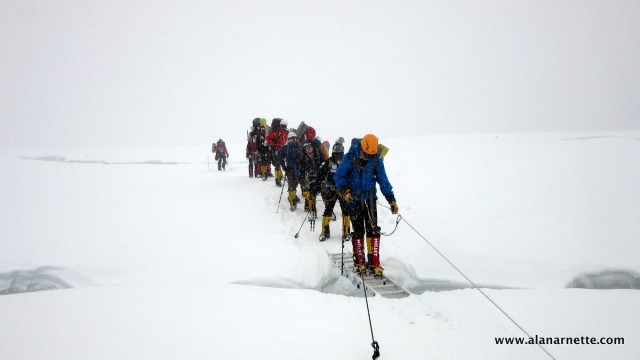
The trail flattens, and a deep crevasse is next. There is a single ladder you use to cross it, remembering to clip into both safety ropes. You had heard about one crevasse a few years ago that had eight ladders lashed together. A bad version of an Icefall Doctor joke! Even the Sherpas went around that one.
You make steady progress, mostly looking at your feet. You pause to swap your carabiner “safety” line across an anchor. Every hundred meters or so, the fixed rope is tied to a snow picket buried deep in the snow. You must unclip your ‘biner and clip back in at each junction. There are many, many of these. You learned how to do this efficiently in the Icefall. Your journey continues.
About 10:00 a.m., the sun begins to rise above Lhotse. “Oh, Lhotse, how could you be so mean!” You immediately begin to sweat. The entire group stops to take off a layer. Thankfully, you knew enough to bring a lightweight polyester shirt, white. You feel a bit cool at first, but as you put your pack back on and begin to walk, you get hotter and hotter. “Valley of Silence?” It’s the Valley of Furnace!!”
As you lift your head, you squint to locate Camp 2. You’ve been going for two hours now. How bad can it be? All you see is a gentle rise. Head slightly higher. Trudge on. The team stops for a quick water break. Sitting on your pack, a Sherpa train, empty of loads, passes by as smoothly and quickly as Olympic marathon runners. You appreciate the breeze they create in the still air. Looking around, you remember why you are here.
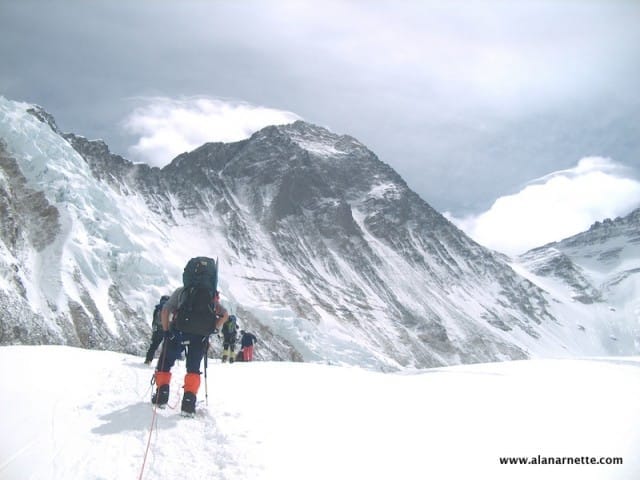
This is one of those moments. Browsing the landscape, your eye follows the skyline of the ridges, the individual peaks, and the harsh and rugged terrain that defines a mountainside—the dichotomy of beauty and danger. The sky is a clear, almost transparent blue you’ve never seen. As you look toward Everest, you see a high rocky ridge. Is that the South Summit, the Cornice Traverse? You are not sure and will ask Dawa when you can.
“Lets go!” a taskmaster barks.
More trudging. You are now really hot, even hotter than you were when you were hotter. Again, you try to spot your destination. Now you see a definite rise off to the left in the distance. “That must be it!” you promise yourself, and trudge on. Now you look up again, sighting your destination beacon you identified a half an hour earlier. You are no closer. It seems to have moved further away!
You see the heat vapors rising from the snow. Your mind wanders. A vision comes into your now wavering psyche. It’s a scene from Lawrence of Arabia or one of those Race Across the Sahara documentaries where someone dies each day. You trudge on.
“It can’t be far now, but how far is it?” you mumble. One of your teammates replies, “Yeah.” And you trudge on.
No more ditches, no more crevasses, you are on flat terrain. So why are you getting out of breath? You stop and put your hands on your knees. You head bows to nature.
You think you see tents! Yellow, green, orange tents! The mirage of Camp 2 is now fully visible. Or is it?
Camp 2
That night at Camp 2, you reflect on the day. It was a long climb from base camp to C1 and now it felt long going to 2. You felt like turning back a few times, but you didn’t. Now, you wonder if you really have what it takes to get to Camp 3, another 2,000’/600m higher. It’s not that far. You have done more in one day–but not at this altitude. You begin the process of bargaining. You need to have this conversation now, not halfway up the Lhotse Face. You drift off to sleep in a college-style debate – with no winner.
After a day at C2, your mission has sunk in. Climb the steep and icy Lhotse Face to Camp 3, rest for a short time, and come back down. Now it’s time. You know the routine by now: up early, struggle to get your clothes and boots on, try to force down some semblance of breakfast, wiggle the harness on, then strap the crampons to your boots, meet up with Pasang, and start moving.
Ballet on the Lhotse Face
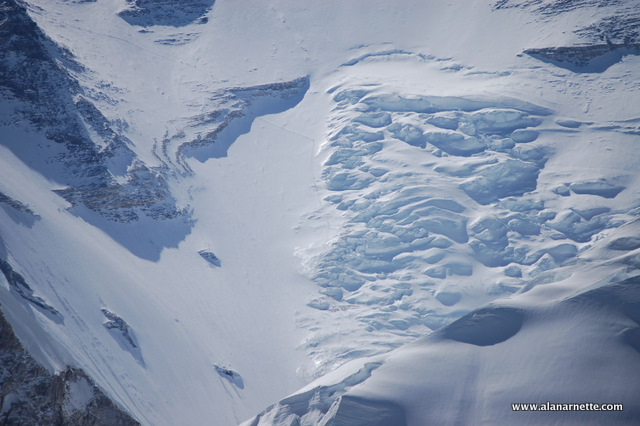
The walk to the base of the Lhotse Face feels almost flat, even though it gains a few hundred feet. You arrive at the base and stop in your tracks. The Face seemingly becomes vertical. You know it’s really only 30 degrees, similar to a staircase, but you are overwhelmed for a moment. Once again, you fight the doubts.
Moving towards the end of the rope, you take your jumar off your harness and quickly attach it to the safety line. You tug on the mechanical device, feeling the teeth dig into the nylon rope. Your ‘biner is next. This technique has been hammered into you for two weeks now, along with “always have one device clipped into the fixed rope at all times. Never, ever be unclipped!” The guide’s words echo in your mind, and now you internalize why. If you slip now, the fall will end badly.
You cross the only ladder over the bergschrund at the base of the Face. All of a sudden, you feel like you are climbing. Using your hands, you pull on the rope—you know you aren’t supposed to, but you do. You lecture yourself, “Climb with your legs, not with your arms!”
Each step requires thought. This is not walking. Your head is tilted down, watching your feet, the rope, and the icy surface. It’s that surface that is giving you pause. Your crampons were sharp when you left home, but after the last two weeks, they are a bit duller and don’t bite into the ice as quickly as you would like. One step, then another. Pause to breathe. “This going to take forever!” you say again to no one in particular.
The Sherpa behind you mutters something and you stop. He passes you, performing a ballet move. He moves close enough that you can feel his breath. His pack is huge, towering over his head. It has two oxygen bottles strapped to the sides and must weigh 40 pounds. Yours contains a puffy down jacket, an extra pair of gloves, and a water bottle. You stand still, trying not to lose your balance. He unclips his carabiner from the fixed line and moves it around and above you on the rope. Swiftly and with ease, he does the same with his jumar. Within a minute, he disappears over a rise on the Face. You stand silent, in awe of his skill and strength.
With a deep breath, you take one step higher and pause again.
The multiple climbing groups had spread the team out. As expected, the last group was struggling. A guide called out, “We’re doing well. Let’s keep this pace. Only a few more hours.” You look at a teammate and wink. He forced a small grin back.
Suddenly you see tents ahead that appeared out of nowhere. The climb thus far had been a series of steep sections followed by a short flat spot – a cruel trick. But the tents were a welcome sight.
However, there were three Camp 3s! Another cruel trick. The Face was too steep to put the tents for all the teams in one spot. Of course, your camp was at the highest level. The irony was that this was both good news and bad news. During this rotation, you curse the extra climbing time, but on the summit push, you would have the advantage of making the distance to the South Col a bit shorter. Also, you would sleep tonight higher than anyone else, another mixed bag.
Passing by tents, you see fellow climbers in their tents. Smiling at them as they take your picture, but also you are envious that they are resting; their climb over for today. Jealously fuels your steps higher. You focused on your form. Step, plant the ice axe, step, move the ‘biner, step, move the jumar, stand up straight, look ahead, smile for the camera!
Passing the last of the tents, a high bump in the ice came into focus. If you were home where you trained, you would pass this in a matter of minutes, maybe seconds. But at 23,600 feet, you stop and stare at the obstacle. Breathing heavily, you mustered whatever was left in your fuel tank and took a few more steps. Higher, slower; the climb was taking a toll on your body. You glance over your shoulder at a few other climbers, who were close behind. “Almost there?” you asked a Sherpa bringing up the rear. “Yes, close. Bistari, bistari.”
Moving on, you no longer looked anywhere but at your feet interrupted by a short glance at the next anchor. Your style is zombiesque.
A familiar voice called out. It’s a Sherpa from your team. He waves at you with enthusiasm to come towards his yellow tent. You step carefully through a maze of lines that secure the tents to the mountainside. Slowly, you moved towards him, having no real choice but to move slowly. You are knackered.
Finally reaching your tent, you collapse in a down-covered heap. Careful with your crampons, you finally look up to see where you are. Your breathing continued to be heavy. Now, you have the hundred-yard stare. A bit of water helps begin your recovery.
Slowly you began to come around. Your mind thinks like you are texting on your phone with a simple OMG. It was justified. The scene before you defy words. OMG. Slowly your eyes traced the perimeter: Nuptse to your left, the Western Cwm front and center, Everest to the right.
Were you really there? Again, you scanned the view. Now, you see Pumori. It looks tiny compared to how it dominates the view at Base Camp. But you were more than a mile high, looking down on the summits of mere 20,000-foot peaks.
On the horizon, you spot Cho Oyu, the world’s 6th highest peak. You recognized the flat summit plateau. “Maybe that will be next,” you think.
You are pleased with how quickly you recover after more water and food. Your breathing has slowed, and your heart rate is steady. You were back in control.
Sitting on the snow-covered Lhotse Face, it sank in that you were climbing Everest—well, technically, Lhotse. You glance over your right shoulder and see the massive shoulder of the world’s highest mountain.
Taking a deep breath and slowly letting it out, you lean against your pack. The rest of the team was getting closer. You glanced at the timer on your watch, 6 hours and 57 minutes, and smiled.
You crawl into your -20 sleeping bag, shaking in the cold. Your T-shirt is soaking wet with sweat, making your bare stomach feel like a slippery eel. Yeah, someone told you to put your wet clothes against your bare skin to dry them out overnight while you slept. They said it would freeze if you left it out in the tent. Now you are thinking this was a good April Fool’s joke. Pull the shirt out of your previously warm and dry base layer top and kick it to the bottom of your bag with your socked feet. You give it an extra push for no good reason.
What a difference a couple of hours makes! All day long, it was miserably hot. A few periods of respite were when a cloud would block the penetrating rays from the sun as the Western Cwm went from baking to broiling on the oven control panel. As soon as the sun went down, it was back to what you thought it should be – a three-yak night. Damn, where is that dog?
Climb On!
Alan
Memories are Everything
Nepal Permit Update
Across Nepal’s climbing peaks, through April 25, 2025, the Ministry of Tourism collected USD 5.2 million in royalties, with Everest accounting for USD 4.6 million. Thus far, 1,025 permits have been issued for 26 mountains this spring, with climbers from the US topping the nationality list at 151, with India second at 124. This is the 2025 tally for the 8000ers:
| 8000er | Teams | Male Clients | Female Clients | Total |
| Annapurna I | 6 | 49 | 17 | 66 |
| Cho Oyu | – | – | – | – |
| Dhaulagiri | 2 | 9 | 6 | 15 |
| Everest | 43+ | 353+ | 74+ | 444 |
| Kanchenjunga | 4 | 26 | 15 | 41 |
| Lhotse | 9 | 85 | 22 | 107 |
| Makalu | 7 | 60 | 17 | 77 |
| Manaslu | – | – | – | – |
| TOTALS | 71 | 582 | 151 | 733 |
Climb On!
Alan
Memories are Everything
An email notification is sent to everyone on the mailing list for each new post. If you would like to see anything special this year, post a comment or drop me an email.
Climb On!
Alan
Memories are Everything
Here’s the Podcast of this Weekend Update
The Podcast on alanarnette.com
You can listen to #everest2025 podcasts on Spotify, Apple Podcasts, Breaker, Pocket Casts, RadioPublic, Anchor, and more. Just search for “alan arnette” on your favorite podcast platform.
Previous Everest 2025 Season Coverage Posts
- Everest 2025: Weekend Update May 4–Waiting on the Ropes
- Everest 2025: Climbers to Watch and a Death on Ama Dablam
- Everest 2025: Weekend Update May 4–On the Move!
- Everest 2025: Climbers to Watch and a Death on Ama Dablam
- Everest 2025: Weekend Update April 27–On the Move!
- Everest 2025: Remembering The Day Nepal Shook–10 Years Later
- Everest 2025: When Will They Summit?
- Everest 2025: Weekend Update April 20–Base Camp Sprawl
- Everest 2025: April 18, A Day to Remember
- Annapurna 2025: Podcast with John Black on Sherpa Deaths
- Everest 2025: Weekend Update April 11
- Annapurna 2025: Summit and Missing Sherpas
- Everest 2025: Weekend Update April 6
- Annapurna 2025: Risky Decisions – April 5 Update
- Everest 2025: Weekend Update March 30
- Everest 2025: Weekend Update March 23
- Everest 2025: Welcome to Everest 2025 Coverage – an introduction to the Everest 2025 Spring season
- Everest by the Numbers: 2025 Edition – A deep dive into Everest statistics as compiled by the Himalayan Database
- Comparing the Routes of Everest: 2025 Edition – A detailed look at Everest’s routes, commercial, standard and non-standard
- How Much Does it Cost to Climb Everest: 2025 Edition – My annual review of what it costs to climb Everest solo, unsupported, and guided
Why this coverage?
I like to use these weekend updates to remind my readers that I’m just one guy who loves climbing. With 38 serious climbing expeditions, including four Everest trips and a summit in 2011, I use my site to share those experiences, demystify Everest each year, and bring awareness to Alzheimer’s Disease. My mom, Ida Arnette, died from this disease in 2009, as have four of my aunts. It was a heartbreaking experience that I hope no other family will go through; thus, I asked for donations to non-profits, which 100% go to them and never to me.
![]()

- Ida Arnette 1926-2009
What Makes Summit Coach Unique?
At Summit Coach, we emphasize the entire preparation process for your climb beyond physical training. We begin with fitness, skills, and experience, then incorporate the mental and emotional tools necessary for a successful climb. Your teammates are welcome to join you at a discount, and we encourage your family to participate in your engagement so they understand what to expect during your climb. We strive to be affordable and provide our services at fair prices. Please visit the Summit Coach website for information on prices and offerings.


